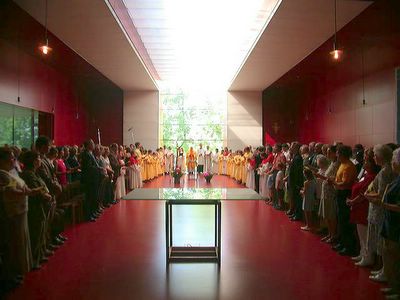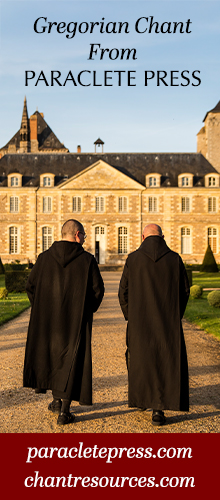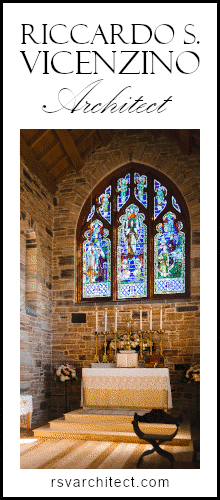I recently commented on the fact that many of the divisions in the Church are not caused by the liturgy itself; this rather is a mere symptom of a bigger problem.It continues to be driven home in my mind that the hermeneutic of rupture today is our single biggest area of much needed re-catechesis. Attitudes must be reformed; hearts changed. The inheritance and accumulated insight of Christendom must again be valued. The value of this tradition, continuously passed on through the centuries, must again be recaptured for many people, and they must come to realize that it something very relevant and pertinent to say to the modern world. People must be extracted from philosophies of relativism which fail to recognize the permanent value of divine revelation, or which would give the scriptures, the Ten Commandments and everything else ecclesial a proverbial "expiry date."
The pressure of this contrary hermeneutic is something which Christendom faces both from without, in terms of the secular world, and from within.
A recent article in Time Magazine, A Step Backward for Pope Benedict? hightlights both of these fronts of the hermeneutic of rupture.
Of course, from the secular perspective, this is no surprise -- mind you, secular journals are not created in a vacuum. Some of their writers will of course be Catholics. Indeed, whether certifiably secular, or whether a lay Catholic in the world, working in the Church, and most certainly some priests, are either proponents of, or are formed by, this contrary hermeneutic.
There are indeed close parallels in terms of agendas and principles, both from without and from within:
"Eighteen months ago, one Rome-based progressive cleric had said he was "surprised to see that [Benedict] seems to be open to hear new ideas." But today, the same priest is disappointed. There has been no sign of any of the hoped-for reforms: overturning the ban on communion for divorced and remarried Catholics, reconsidering the celibacy requirement for priests, allowing gays in seminaries, or a softening of the condom ban to allow for distribution in AIDS-ravaged Africa." Seeing these other, non-liturgical issues are important in terms of contextualizing precisely the scope and import of the hermeneutic of rupture. New teachings are desired and accordingly of course, new disciplines to coincide with them. Because the liturgy is precisely the bearer of doctrine, it is an important part of the whole equation. If this were not the case, then really, why would the liturgical forms ultimately matter? They precisely do matter, because they do teach and assert both doctrine and one or another hermeneutic.
Seeing these other, non-liturgical issues are important in terms of contextualizing precisely the scope and import of the hermeneutic of rupture. New teachings are desired and accordingly of course, new disciplines to coincide with them. Because the liturgy is precisely the bearer of doctrine, it is an important part of the whole equation. If this were not the case, then really, why would the liturgical forms ultimately matter? They precisely do matter, because they do teach and assert both doctrine and one or another hermeneutic.
In all these questions, whether we're talking about the reform of the reform, or the wider use of the classical liturgy, we're talking about the popular modern paradigm of "old church" vs. "new church". It's an idea often expressed and believed in our day, even by those who aren't terribly aware of the issues that surround this, or the principles that underly it.
Traditional liturgical forms are one of the prime aspects of this question because it comes to represent what the hermeneutic of rupture would view as the "old church". But note, this isn't simply a question of style, but also one of substance -- and the two are related. It relates fundamentally to both Catholic discipline and Catholic doctrine. The precise import of this relationship is also why the modern tendency to consider liturgical forms as subjective and unimportant is so dangerous. Such an over-assertion can have Titanic like consequences.
Different Hermeneutics and Different Lessons
Example 1: The post-conciliar liturgy (and reform) taken in the interpretive light of a hermeneutic of rupture, which seeks to redefine the church in its own image:


Example 2: The post-conciliar liturgy when taken in the interpretive light of continuity:


Example 3: The classical tradition:
Each of these images comes in the context of the liturgy, under some manner of Catholic auspices. I am indeed showing some of the worst and some of the best, but this is precisely to highlight the point that underlying the forms and ceremonies of the rites are both important in form and function because of their co-relation.
The underlying principles affect the shape and form given to the liturgy, and that in turn is passed back to those who attend these liturgies. What form this takes is greatly dependent upon the hermeneutic adopted.
Summary
That it is not just about the liturgy and a Council, but something, broader in scope, is precisely pointed to by the fact that even those who simply wish to adopt a traditional liturgical ethos in the present, post-conciliar liturgical books are accused of "backsliding" or turning back the reforms. How can they be turning back the reforms of the Council, when that very Council and all the Popes thereafter have asserted this ethos as good and proper? They can only be accused of this if we understand the post-conciliar reforms not according to the letter of the Council or the mind of the Church, but in the "interpretive key" of the hermeneutic of rupture, which spans this issue and others. The real issue here then is not the rolling back of the Council, but rather the re-assertion of a hermeneutic of continuity.
Herein lay the real crux of the matter today.




















